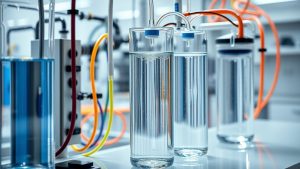
A wash bottle is a lab tool used for rinsing and cleaning glassware to maintain high cleanliness standards, essential for accurate experiments. It's made from polyethylene, making it resistant to many chemicals. The long nozzle allows for precise dispensing of distilled or deionized water and other solvents. Use it to remove contaminants from beakers, test tubes, and flasks, ensuring your results are reliable. Learn more about its various applications and design features next.
Wash bottles are vital tools in any laboratory, primarily designed for rinsing and cleaning glassware efficiently. Their functionality allows you to maintain a high standard of cleanliness, which is essential for accurate experimental results. Typically constructed from polyethylene, these bottles resist many chemicals, making them suitable for various laboratory applications. Common solvents used in wash bottles include distilled water, detergent solutions, and organic solvents like acetone. This versatility guarantees that you can choose the right liquid for your specific cleaning or rinsing task.
When rinsing glassware, wash bottles prove to be particularly effective. You can easily target beakers, test tubes, and flasks, ensuring that contaminants are thoroughly removed. The long nozzle design allows for precision dispensing, directing the liquid flow where it's needed while minimizing waste. Using distilled or deionized water in these bottles assures the purity of your experiments, eliminating variables that could skew results. This ease of use enhances laboratory efficiency by providing a convenient means of cleaning without requiring an access point like a sink. Additionally, wash bottles are essential for maintaining cleanliness in experiments, making them indispensable tools in any lab setting.
In terms of chemical applications, wash bottles are invaluable. You can use them for delicate solution handling, such as diluting concentrated solutions with precision. They're also essential for spot testing, allowing you to dispense reagents accurately during chromatography or other analytical methods. Whether you're adjusting pH levels by adding small amounts of acid or base or cooling small equipment and reaction vessels, wash bottles streamline these processes. They even play a role in flame tests, where consistent application of salt solutions is necessary.
Furthermore, wash bottles facilitate various experimental tasks. They enable the transfer of small volumes of liquids into narrow-necked vessels, which is often required in complex procedures. When preparing thin-layer chromatography (TLC) chambers, you can easily add the mobile phase using a wash bottle. They're also effective for washing precipitates during filtration processes, ensuring that all relevant material is retained. Additionally, you can quickly sanitize work surfaces by dispensing disinfectants or cleaning solutions, promoting a sterile environment essential for reliable results.
The design of wash bottles emphasizes safety and usability. They typically feature a cylindrical shape with a screw-top cap and a long bent nozzle, enhancing control during dispensing. Made from chemically inert materials, these bottles prevent contamination of the liquids they contain. Color coding is often employed to indicate the type of solvent inside, providing an immediate visual cue for safe handling.
While using flammable solvents like acetone, it's essential to observe safety precautions to prevent accidents.
Conclusion
In conclusion, a wash bottle is your handy companion in the lab, designed to simplify the dispensing of liquids with grace and precision. By employing this tool, you're not just handling chemicals; you're engaging in a delicate dance of science. Whether you're rinsing glassware or dispensing solvents, its user-friendly design guarantees you maintain control over your work. So, embrace the art of fluid delivery, and let your wash bottle elevate your experimental endeavors without a hitch.



